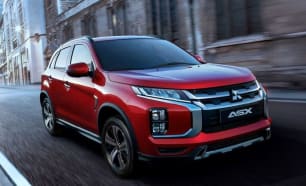The UX’s compact crossover-esque hatchback proportions have implications inside. Inevitably, this is no larger than the (related) Toyota Corolla, despite having the higher seating position.
Beyond that, though, the 2023 model highlights how Lexus has made its so-called ‘gateway’ model better than before.
For starters, despite being the base grade, this UX has a properly premium ambience, backed up by exceptional fit and finish.
From a sensory perspective, the UX looks, smells, feels and sounds like a Lexus should. And by the latter, we mean the cabin is pleasingly isolated from the outside world.
The overhauled touchscreen and multimedia system is a huge step forward for the series. The larger new display looks great and works well – what a monumental improvement over the infuriatingly fiddly old set-up. It’s difficult to see how they’ll improve it. Dependable and glitch-free. Are you listening, all European manufacturers?
Meanwhile, the carryover parts that worked well enough before continue to impress.
The UX’s front seats are sumptuous in their cushy softness and comfort, yet provide sufficient support over longer driving distances.
There’s also the excellent driving position, with most switchgear within grasp. There’s just enough space for taller people to settle in nicely up front. And the basics like ventilation and storage are thoughtfully executed. The climate in the UX is always fine.
Negatives? Don’t worry, we’ve identified several.
As mentioned earlier, the now-better-equipped Luxury does have all the essentials. But for a car that’s approaching $60K-drive-away, we’d expect kerb-side mirrors that dip down when reversing to avoid damaging alloys against gutters; we couldn’t get ours to auto-fold when locking up, either.
Driver vision out isn’t great. Thick pillars and that rising shoulder line make changing lanes and reversing a technology-reliant affair, as it’s difficult to see objects that are too-easily obscured. For the same reasons, a front camera would be useful in this grade.
Others might expect a sunroof, or cooled seats that massage, or a head-up display for the instrumentation, but we’d argue that they’re hardly necessities. Lexus has to upsell buyers to something.
Moving on to the back-seat area betrays the UX’s compactness most.
The back doors have small apertures. Entry/egress is challenging for folk with long legs. Legroom is tight, and three adults abreast would be a struggle, so it’s best to treat the littlest Lexus crossover as a four-seater.
Yet headroom is fine, the appearance and finish remain first class as it is up front, and the basics are all present – air vents, grab handles, coat hooks, overhead lighting, one map pocket, centre armrest with cupholders, two USB outlets, and windows that wind all the way down. Narrow front seats aid with light, vision and ambience, too.
Further back, the luggage area is pretty petite for an SUV, though the boot is (slightly) larger than the Corolla and Mazda3’s. That powered tailgate is useful if your arms are full, but the loading lip is high.
Normal boot floor depth is shallow but most of that flooring can be removed to reveal a hidden compartment underneath.
Small side pockets are also useful. You’ll find a 240V outlet. Bag hooks and floor tie-down hooks are fitted.
And – being a hybrid – there’s no spare wheel, just a tyre inflation kit. And the flimsy cargo cover is there only to keep prying eyes out.
Not big on utility, then, but the UX is true to its role as a Lexus in concentrate form.

